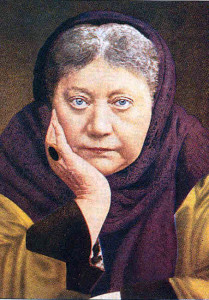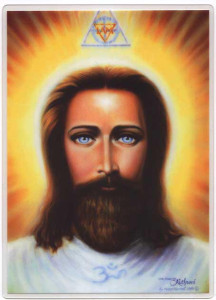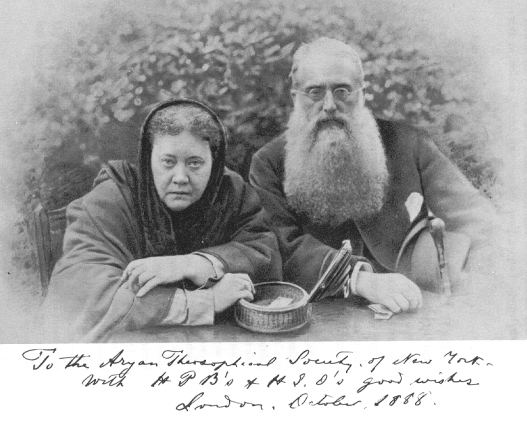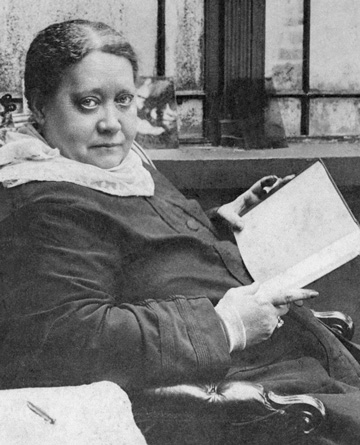 Madame Helena Petrovna Blavatsky, HPB for short: fakir or faker? To her believers, she was a psychic miracle-worker, a fearless traveller to exotic places, a conduit to the Masters in whom reposed all occult wisdom; to her detractors, a shameless charlatan, a pathological liar, a plagiarist, a self-serving purveyor of nonsense. What both sides can agree on is this: she was colourful, larger than life, personally charming, and gifted with colossal nerve, and the tales she spun in the late 19th century have affected the culture of the occult ever since.
Madame Helena Petrovna Blavatsky, HPB for short: fakir or faker? To her believers, she was a psychic miracle-worker, a fearless traveller to exotic places, a conduit to the Masters in whom reposed all occult wisdom; to her detractors, a shameless charlatan, a pathological liar, a plagiarist, a self-serving purveyor of nonsense. What both sides can agree on is this: she was colourful, larger than life, personally charming, and gifted with colossal nerve, and the tales she spun in the late 19th century have affected the culture of the occult ever since.
Born in the Ukraine in 1831 as Helena von Hahn, with an aristocratic Russo-German lineage, HPB was a wild child with a talent for story-telling and a rich menagerie of invisible friends—at least one of whom, as described in a later hagiography, was one of the Mahatmas whom she later encountered in Tibet. In June of 1848, aged 17, she wilfully married a fortyish official named Blavatsky, thus acquiring the surname she would still be using at her death. But a settled life as an affluent Russian wife was not the fate she embraced. She abandoned her marriage within months, eluded her family, and ran off to Constantinople to embark upon a series of astonishing adventures.
That is, she claimed to have had astonishing adventures, but even her most pious biographers will admit that corroborating evidence is thin on the ground. She appears to have drifted round Europe and the Levant, working as a piano teacher or a circus bareback rider, the wife of up to three vanished husbands, possibly the mother of a short-lived child, and then a long stint as a spirit medium, including an association (and a falling-out) with the infamous Daniel Dunglas Home. She later downplayed any association with spiritualism, however, and provided fabulously alternate versions of her wanderings.
By her own account, she travelled the whole world, including the Americas, but most notably became one of the few white women to penetrate the mystic places of the Far East. In particular, she claimed to have broken through the barriers around Tibet, or order to study under—and achieve enlightenment from—a group of Tibetan super-sages she called the Mahatmas. She also claimed to be a virgin.
 The Mahatmas, aka adepts, aka Masters of Ancient Wisdom, aka the Great White Brotherhood were, according to HPB, a secret society of enlightened and highly evolved beings, once mere humans, but now immortal and able to wield great powers of mind and will in the service of Planet Earth. Dwelling in remote places, for example Tibet, they had chosen HPB to be their agent in spreading the ancient wisdom of the East to the hungry hearts of the West. Her chief contacts, Kuthumi and Master Morya, followed up her on-site training in Tibet with distance training via psychic contact, and even by writing her pen-and-ink letters that apported to her out of thin air—at least, that is what she claimed. It should be noted that the Masters tended to be whitish or subcontinental Indian, some with eyes as piercingly blue as Blavatsky’s own. Also note that credible scholarship suggests Kuthumi and Co owe a great deal to Blavatsky’s fondness for certain romantic novels of Bulwer-Lytton.
The Mahatmas, aka adepts, aka Masters of Ancient Wisdom, aka the Great White Brotherhood were, according to HPB, a secret society of enlightened and highly evolved beings, once mere humans, but now immortal and able to wield great powers of mind and will in the service of Planet Earth. Dwelling in remote places, for example Tibet, they had chosen HPB to be their agent in spreading the ancient wisdom of the East to the hungry hearts of the West. Her chief contacts, Kuthumi and Master Morya, followed up her on-site training in Tibet with distance training via psychic contact, and even by writing her pen-and-ink letters that apported to her out of thin air—at least, that is what she claimed. It should be noted that the Masters tended to be whitish or subcontinental Indian, some with eyes as piercingly blue as Blavatsky’s own. Also note that credible scholarship suggests Kuthumi and Co owe a great deal to Blavatsky’s fondness for certain romantic novels of Bulwer-Lytton.
To cut a long story short, Blavatsky moved to the US in the early 1870s and became “chums” with a much-bearded journalist named Henry Steel Olcott, who had a strong interest in spiritualism and an openness to the Great White Brotherhood. Together, the chums formed the Theosophical Society in New York in 1875, though without much luck at first; it was not until they moved their operation to India in 1879, hoping to reimport Eastern culture to the East, that the TS began to gather strength. It rapidly took on the form of a cult centred around Madame, informed by her metaphysics, her philosophy, and her revelations from the Mahatmas about Earth’s long prehistory. All of these, she presented in a string of thick, densely written books and pamphlets.
Blavatsky comes across as a typical messianic character— highly intelligent and charismatic, egoistic and demanding of attention, apt to fly into foul-mouthed rages when she didn’t get enough of it, hypnotically charming when she did. But her claim to have a special relationship with the Mahatmas was bolstered in the eyes of her followers by her wide range of psychic capabilities, including telepathy, levitation, clairvoyance, mediumship and materialization of solid objects out of thin air, which she used to impress her growing body of disciples.
She was, of course, a trickster, using fairly crude illusions to fool the faithful. But when her miracles were exposed as trickery, sleight of hand and outright fraud—it did not matter. When her writings were shown to be massively plagiarized, and a total misrepresentation of Buddhist Tibetan beliefs and culture—it did not matter. When she and Olcott had a bust-up of a most unethereal and unenlightened nature—it did not matter. She remained then, and remains now, a star of esoteric culture.
What was Theosophy, her message from the Mahatmas? Essentially, it was a soup of metaphysical verbiage, practically unreadable except by enthusiasts, and absolutely unrelated to genuine Sanskrit scholarship, but with some interesting sidelights on world history and the origins of humankind. Madame Blavatsky, for example, was the one who added the mystical component to the Atlantis myth, which earlier in the nineteenth century had been treated more as an exciting hyperdiffusionist archaeological puzzle.
A prime revelation was that Earth’s history involved a sequence of “Root Races” succeeding each other at long intervals, going back millions of years—her answer to Darwinian evolution:
- Astrals (pure spirits, like astral jellyfish)
- Hyperboreans (whose continent sank)
- Lemurians (twelve-foot three-eyed lizards, whose continent sank)
- Atlanteans (who looked human, and were psychic, and had advanced technology and mystical energy sources, but whose continent sank), and
- Aryans, the Race of Hope – which is us. Or some of us, at least. The racist element was strong.
The split with Olcott came in 1885, after which she was more or less banished to Europe to write books, while still maintaining her charisma, authority, and near-stranglehold on communications with the Mahatmas. But even her remarkably powerful personality could not defeat death—she died of Bright’s disease in 1891, at the relatively early age of 59. Theosophy, however, remained strong and healthy, and attracted an astonishing array of talented and influential people over the next few decades before it began to fade and take its place among similar fringe faiths.
But Blavatsky’s legacy goes far beyond the Theosophical Society—she was not just a precursor to the New Age, but in some ways foundational to it. Her movement split early on, into the exact equivalent of denominations, under leaders like Rudolf Steiner, Annie Besant, Katherine Tingley, George Gurdjieff, Peter Ouspensky, Guy Ballard, and Alice Bailey. It echoed in the pronouncements of Edgar Cayce and Lobsang Rampa, and provided a hand-me-down occult narrative for such derivative messiahs as Dorothy Martin, Brother Twelve, and Elizabeth Clare Prophet, among many others. Controversy still rages about how great her influence was on Heinrich Himmler and other racist Nazi theorists. Nor is that the only controversy – see, for example, the bitter backchat between skeptics and true believers regarding Blavatsky’s wiki page. More than 120 years after her death, she is still the centre of a storm of attention.
I’m sure she’d have liked that.


